
Here’s a comprehensive post titled “What is Serverless Computing? The Future of Cloud Development” with expanded content for each section:
Understanding Serverless Computing
Serverless computing is a cloud computing model that allows developers to build and run applications without managing infrastructure. While the term “serverless” suggests that no servers are involved, it actually means that developers do not have to worry about the underlying servers or infrastructure required to run applications. The cloud provider automatically manages the resources, scaling, and provisioning needed for the application to function. This allows developers to focus solely on writing code, improving efficiency and accelerating development cycles.
In this post, we will explore the concept of serverless computing, its core features, benefits, and the technologies driving this paradigm. We will also look at the future of serverless computing and its impact on cloud development, including trends and emerging use cases.
Key Features of Serverless Computing
- No Infrastructure Management: Developers don’t need to manage servers or worry about scaling infrastructure; the cloud provider handles it.
- Event-Driven: Serverless applications are typically event-driven, meaning functions are triggered by specific events or requests (e.g., HTTP requests, file uploads).
- Scalability: Serverless platforms automatically scale based on demand, meaning applications can grow or shrink as needed without manual intervention.
- Cost Efficiency: With serverless computing, you only pay for the compute time you use, which reduces costs compared to traditional cloud models where you pay for provisioned resources.
- Simplified Deployment: Deployment becomes easier and faster as developers can focus on code, leaving the infrastructure management to the cloud service provider.
1. How Serverless Computing Works
Serverless computing works by abstracting the infrastructure layer and allowing developers to focus on writing application logic. The cloud provider manages everything, from provisioning servers to scaling and maintaining the environment. In this model, developers create small, independent functions that respond to specific events or triggers, and these functions execute in stateless containers.
Key Elements of Serverless Architecture
- Functions as a Service (FaaS): Serverless applications are built using small units of code, called functions, which execute in response to events. Popular platforms like AWS Lambda and Google Cloud Functions allow developers to deploy and manage functions without managing servers.
- Event-Driven Architecture: Serverless computing is often used in event-driven architectures where functions are triggered by events such as HTTP requests, database changes, or file uploads.
- Managed Services: In addition to FaaS, serverless computing often includes other managed services such as serverless databases, API gateways, and storage solutions, which help manage infrastructure automatically.
- Microservices: Serverless computing supports microservices architectures, where each function can serve a single purpose and interact with other functions to complete a task. This promotes modularity and flexibility.

2. Advantages of Serverless Computing
Serverless computing offers several advantages that make it an attractive choice for developers and businesses. From cost savings to simplified application architecture, the benefits of serverless computing are numerous.
Key Benefits of Serverless Computing
- Cost Efficiency: With serverless computing, you only pay for the compute time used by your functions, rather than paying for always-on virtual machines. This results in cost savings, especially for applications with unpredictable traffic or low usage.
- Scalability: Serverless platforms automatically scale based on traffic. Whether you have a few requests or millions, the platform adjusts the resources accordingly, providing seamless scaling without the need for manual intervention.
- Faster Time to Market: Serverless computing accelerates development cycles by offloading infrastructure management to the cloud provider. Developers can focus purely on building features and writing code, leading to quicker releases and iterations.
- Reduced Operational Overhead: With no need to manage servers or infrastructure, teams can focus more on application logic and business requirements. The cloud provider handles all aspects of resource provisioning, patching, and maintenance.
- Improved Reliability: Serverless platforms are highly available and fault-tolerant by design. The provider ensures that your functions are distributed across multiple regions and are protected against failures.
3. Use Cases for Serverless Computing
Serverless computing is being adopted across various industries and use cases. From real-time data processing to microservices, serverless offers flexibility and efficiency for developers looking to build scalable applications without the complexity of managing infrastructure.
Common Use Cases for Serverless Computing
- Web Applications: Serverless is well-suited for web applications with varying or unpredictable traffic patterns. Using functions to handle API requests and database queries allows businesses to scale their applications dynamically.
- Data Processing: Serverless computing is ideal for data processing tasks that require parallel execution, such as image processing, video transcoding, or real-time analytics.
- Microservices: Each microservice can be implemented as a serverless function, making it easier to build and deploy loosely coupled applications. This promotes scalability and modularity in application design.
- Chatbots and AI: Serverless functions are commonly used to power chatbots, AI applications, and machine learning workflows, where the ability to scale based on demand is crucial.
- Event-Driven Applications: Serverless computing excels in event-driven scenarios, where functions are triggered by changes in data, like file uploads, database updates, or IoT sensor data.
4. Challenges and Limitations of Serverless Computing
While serverless computing offers many benefits, it also comes with its own set of challenges and limitations that developers must consider before adopting it for large-scale applications.
Challenges in Serverless Computing
- Cold Start Latency: One of the most common drawbacks of serverless computing is the “cold start” latency. When a function is invoked for the first time or after it has been idle, it may experience a delay as the platform provisions the required resources.
- State Management: Since serverless functions are typically stateless, managing state can be challenging. Developers need to use external services, such as databases or object storage, to persist state across function invocations.
- Vendor Lock-In: Serverless computing often requires developers to use specific cloud provider platforms (e.g., AWS Lambda, Google Cloud Functions), which can lead to vendor lock-in. This can make it difficult to migrate applications to other platforms.
- Debugging and Monitoring: Debugging serverless applications can be more complex than traditional applications due to the lack of persistent infrastructure. Tools like AWS X-Ray and Google Cloud Trace are available, but debugging can still be more challenging.
- Resource Limits: Many serverless platforms impose limits on function execution time, memory, and storage. These limits can be restrictive for some applications, especially those with long-running processes or heavy resource requirements.
5. The Future of Serverless Computing
As serverless computing continues to mature, we can expect further innovations and improvements that will address current challenges and expand the possibilities for developers.
Emerging Trends in Serverless Computing
- Serverless at the Edge: Serverless computing is expanding to edge locations, allowing developers to run functions closer to users and IoT devices. This will help reduce latency and improve performance for real-time applications.
- Serverless for Machine Learning and AI: With the growing popularity of AI and machine learning, serverless platforms are integrating more capabilities for running machine learning models at scale, making it easier for developers to deploy and manage AI-powered applications.
- Hybrid Serverless Architectures: In the future, we may see more hybrid models where traditional server-based architectures coexist with serverless computing. This allows businesses to combine the best of both worlds and adopt serverless where it makes the most sense.
- Improved Monitoring and Debugging Tools: As serverless adoption grows, we can expect better tools for monitoring, logging, and debugging serverless applications. These tools will help developers gain deeper insights into the performance of their applications.
- Increased Adoption Across Industries: As the benefits of serverless computing become clearer, more industries—particularly healthcare, finance, and retail—are expected to adopt serverless architectures for building scalable and cost-effective applications.
Embracing Serverless for the Future of Cloud Development
Serverless computing is transforming how applications are developed, deployed, and scaled in the cloud. By abstracting away the infrastructure management, serverless platforms allow developers to focus on writing code and building applications rather than managing servers. The benefits of serverless computing, including cost efficiency, scalability, and reduced operational overhead, make it an attractive choice for businesses of all sizes.
While there are challenges such as cold start latency and state management, the future of serverless computing looks promising. As technologies improve and more tools become available, serverless computing will continue to play a key role in the evolution of cloud development. Developers and organizations that embrace serverless will be able to build highly scalable, cost-effective applications faster, improving agility and time to market.
